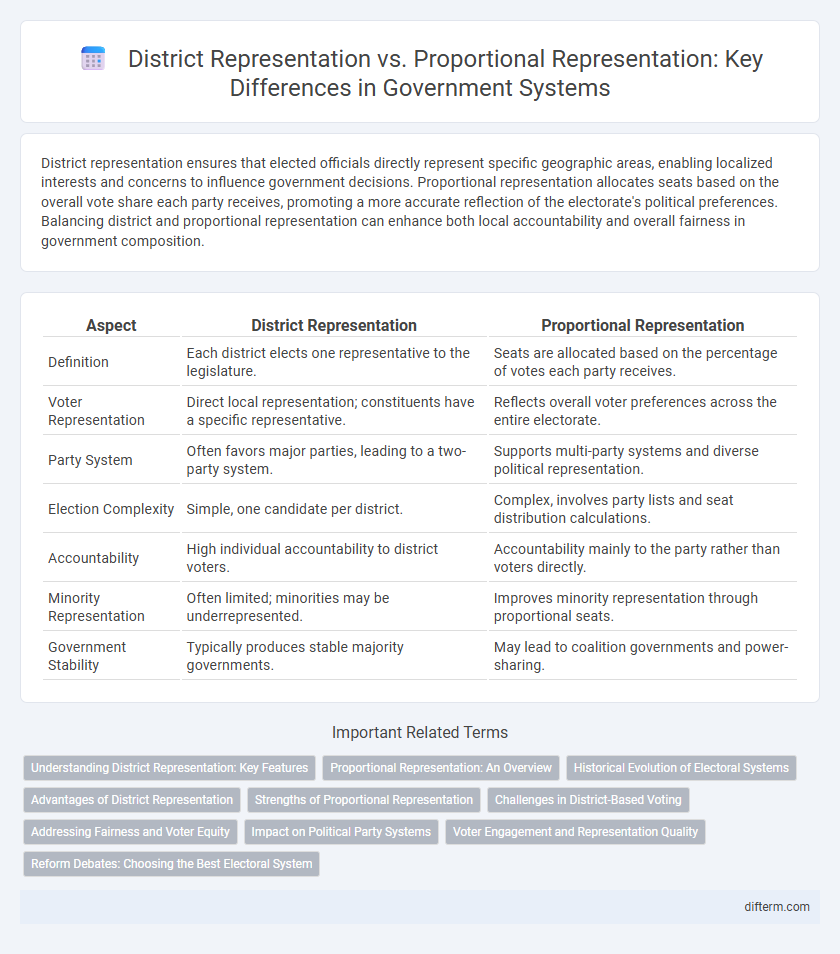District representation ensures that elected officials directly represent specific geographic areas, enabling localized interests and concerns to influence government decisions. Proportional representation allocates seats based on the overall vote share each party receives, promoting a more accurate reflection of the electorate's political preferences. Balancing district and proportional representation can enhance both local accountability and overall fairness in government composition.
Table of Comparison
| Aspect | District Representation | Proportional Representation |
|---|---|---|
| Definition | Each district elects one representative to the legislature. | Seats are allocated based on the percentage of votes each party receives. |
| Voter Representation | Direct local representation; constituents have a specific representative. | Reflects overall voter preferences across the entire electorate. |
| Party System | Often favors major parties, leading to a two-party system. | Supports multi-party systems and diverse political representation. |
| Election Complexity | Simple, one candidate per district. | Complex, involves party lists and seat distribution calculations. |
| Accountability | High individual accountability to district voters. | Accountability mainly to the party rather than voters directly. |
| Minority Representation | Often limited; minorities may be underrepresented. | Improves minority representation through proportional seats. |
| Government Stability | Typically produces stable majority governments. | May lead to coalition governments and power-sharing. |
Understanding District Representation: Key Features
District representation allocates legislative seats based on specific geographic areas, ensuring localized interests and community needs are directly represented in government decisions. Each district elects a single representative, promoting accountability and stronger ties between constituents and their elected officials. This system emphasizes geographic equity in representation, contrasting with proportional representation which focuses on party vote shares across larger regions.
Proportional Representation: An Overview
Proportional representation (PR) is an electoral system designed to allocate legislative seats in direct proportion to the percentage of votes each party receives, ensuring more accurate reflection of voter preferences. Unlike district representation, which often favors major parties through single-member constituencies, PR promotes multiparty inclusivity and minority representation by distributing seats based on overall vote share. Countries like Germany, Sweden, and New Zealand successfully implement PR to enhance political diversity and electoral fairness within their parliamentary systems.
Historical Evolution of Electoral Systems
District representation, characterized by single-member constituencies, traces back to ancient Athens and solidified in British parliamentary practices, emphasizing localized accountability and clear geographic mandates. Proportional representation emerged in the 19th century, with the introduction of the party list system in Belgium (1899) and the single transferable vote in Ireland, aiming to more accurately mirror the electorate's diverse political preferences in legislative bodies. These systems' historical evolution reflects a balance between governance stability through district representation and inclusivity via proportional methods, influencing contemporary electoral reforms worldwide.
Advantages of District Representation
District representation ensures localized accountability by directly linking elected officials to specific geographic areas, fostering a closer relationship between constituents and their representatives. It promotes tailored policy-making that addresses the unique needs and interests of distinct communities, enhancing responsiveness and voter engagement. Furthermore, this system strengthens political stability by simplifying elections and providing clear, direct choices for voters within each district.
Strengths of Proportional Representation
Proportional representation ensures a more accurate reflection of the electorate's political preferences by allocating seats based on the percentage of votes each party receives, enhancing fairness and inclusivity. This system encourages multi-party participation, reducing the dominance of major parties and promoting diverse viewpoints within the legislature. It also increases voter engagement by making every vote count equally, thereby strengthening democratic legitimacy and coalition governance.
Challenges in District-Based Voting
District-based voting often faces challenges such as unequal population distribution leading to malapportionment, which undermines equal representation. Gerrymandering further distorts electoral fairness by manipulating district boundaries to favor specific political parties. These issues contribute to reduced competitiveness and diminished voter influence compared to proportional representation systems.
Addressing Fairness and Voter Equity
District representation ensures localized accountability by electing representatives from specific geographic areas, promoting close constituent relationships and community interests. Proportional representation allocates seats based on overall vote share, enhancing fairness by more accurately reflecting the diverse political preferences of the electorate. Combining both systems can improve voter equity by balancing local representation with inclusive, proportional outcomes that reduce disparities in vote weight.
Impact on Political Party Systems
District representation often reinforces a two-party system by favoring larger parties that can secure pluralities within individual districts, which limits smaller parties' chances of gaining seats. Proportional representation encourages multi-party systems by allocating seats based on the percentage of votes each party receives, leading to greater political diversity and coalition governments. The choice between these systems significantly shapes party competition, voter representation, and legislative dynamics.
Voter Engagement and Representation Quality
District representation often enhances voter engagement by fostering a direct connection between constituents and their elected officials, resulting in higher accountability and localized advocacy. Proportional representation improves representation quality by ensuring political diversity and reflecting a broader spectrum of voter preferences, reducing wasted votes and enhancing minority party inclusion. Comparative studies show that proportional systems increase voter turnout and satisfaction by creating a more equitable and representative legislature.
Reform Debates: Choosing the Best Electoral System
Reform debates on electoral systems critically evaluate district representation and proportional representation to enhance democratic legitimacy and governance effectiveness. District representation often ensures geographical accountability, while proportional representation improves inclusivity and accurate reflection of voter preferences. The challenge lies in balancing local interests with equitable party representation to promote fairer election outcomes and stronger political stability.
district representation vs proportional representation Infographic

 difterm.com
difterm.com